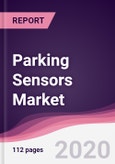Parking Sensors are employed in cars to detect the obstacles during parking. These sensors made the parking job easy for the drivers without actually looking out and can utilize the display that is present inside a car using the sensors. The market for parking sensors was valued at $1796.27m in the year 2020 and is estimated to reach by $6625.16m by 2025 at an estimated CAGR of 24.3%. Amongst various technologies that are being used, ultrasonic sensors generated the highest revenue followed by the electromagnetic sensors. Europe held the largest share of approximately 41.1% of the total share in the market generating a revenue of $722.29m in the year 2020 and is projected to grow at an estimated CAGR of 22.9% followed by the APAC regions.
Parking Sensors Market Outlook:
There are different parking sensors available in the market such as ultrasonic sensors and electromagnetic sensors and many others. Ultrasonic systems generate sound waves, which when hit an obstacle reflects back, thereby calculating the distance of the obstacle from the vehicle. A beeping sound is generated when the vehicle moves close to the obstacle and alerts the driver. Electromagnetic sensors on the other hand, creates electromagnetic field. When the obstacle enters the magnetic field it will generate a warning to the driver. These sensors are offered by both original equipment manufacturers and after-market companies.
The price of an ultrasonic sensor is around $6-$6.8 and $12-$13.1 for an electromagnetic sensor.
Parking Sensors Market Growth drivers:
The increasing regulations by the government towards passengers safety is the major key driver for the parking sensors market. For example, The Hon Paul Fletcher MP, former Australian minister of urban infrastructure and cities had told that the government has started a project of installing the parking sensors and thereby allowing the drivers to link the parking information that is available through mobile applications. The innovations in developing a smart parking system in various countries is also a driver for the parking sensors market. The relentless rise in the usage of safer vehicles is also a driver for the parking sensors market.
Parking Sensors Market Challenges:
When the transmitter installed in one car using a certain channel of frequency overlaps with the same channel of frequency that is used by the other car, then the receiving signal may be corrupted at each other receivers due to the interference caused by the signals.Parking Sensors Market Research Scope:
The base year of the study is 2020, with forecast done up to 2025. The study presents a thorough analysis of the competitive landscape, taking into account the market shares of the leading companies. It also provides information on unit shipments. These provide the key market participants with the necessary business intelligence and help them understand the future of the Parking Sensors Market. The assessment includes the forecast, an overview of the competitive structure, the market shares of the competitors, as well as the market trends, market demands, market drivers, market challenges, and product analysis. The market drivers and restraints have been assessed to fathom their impact over the forecast period. This report further identifies the key opportunities for growth while also detailing the key challenges and possible threats. The key areas of focus include the types of plastics in the electric vehicle market, and their specific applications in different types of vehicles.
Parking Sensors (SAP) Market Report: Industry Coverage
- Parking Sensors Market–By Type: Reverse parking, Front parking
- Parking Sensors Market–By Technology: Ultrasonic sensors, Electromagnetic sensors and Infrared sensors
- Parking Sensors Market– By Offering: Original Equipment Manufacturing, After-market.
- Parking Sensors Market– By Components: Displays, Control modules, Sensors and others.
- Parking Sensors Market – By Application: Passenger cars, Light commercial vehicles and Heavy commercial vehicles.
The Parking Sensors Market report also analyzes the major geographic regions for the market as well as the major countries for the market in these regions.
The regions and countries covered in the study include:
- North America: The U.S., Canada, Mexico
- South America: Brazil, Venezuela, Argentina, Ecuador, Peru, Colombia, Costa Rica
- Europe: The U.K., Germany, Italy, France, The Netherlands, Belgium, Spain, Denmark
- APAC: China, Japan, Australia, South Korea, India, Taiwan, Malaysia, Hong Kong
- Middle East and Africa: Israel, South Africa, Saudi Arabia
Parking Sensors Market Key Players Perspective:
Some of the Key players in this market that have been studied for this report include: TGS, P8, INRIX, Nedap, IEM, Senic Corporation, Murata Manufacturing Co. Ltd., NXP Semiconductors N.V, Robert Bosch GmbH, Texas Instruments Incorporated and many more.
Market Research and Market Trends of Parking Sensors Market
Inrix, a key player in the parking sensors market has integrated ultrasonic sensors with the internet of things technology. The sensors collects the data on parked cars and is anonymously sent to the INRIX Parking cloud. The database used in the INRIX determines the availability of the space to the drivers.
Table of Contents
Methodology

LOADING...








